Toyota's Competitive Strategy: PESTLE, SWOT, and Porter's Five Forces
VerifiedAdded on 2023/06/12
|8
|1765
|325
Essay
AI Summary
This essay provides a comprehensive analysis of Toyota's competitive strategy within the automotive industry, employing Porter's Five Forces, SWOT, and PESTLE frameworks. The analysis evaluates the threat of new entrants, supplier and buyer power, the threat of substitutes, and competitive rivalry, highlighting Toyota's strengths, weaknesses, opportunities, and threats. The PESTLE analysis examines political, economic, social, technological, environmental, and legal factors impacting Toyota's operations. The essay concludes that Toyota's success is rooted in its commitment to product quality and customer-oriented market configuration, recommending continued efforts to strengthen its organizational platform and expand into rapidly growing nations. Desklib provides students with access to a variety of study tools, including similar solved assignments and past papers.
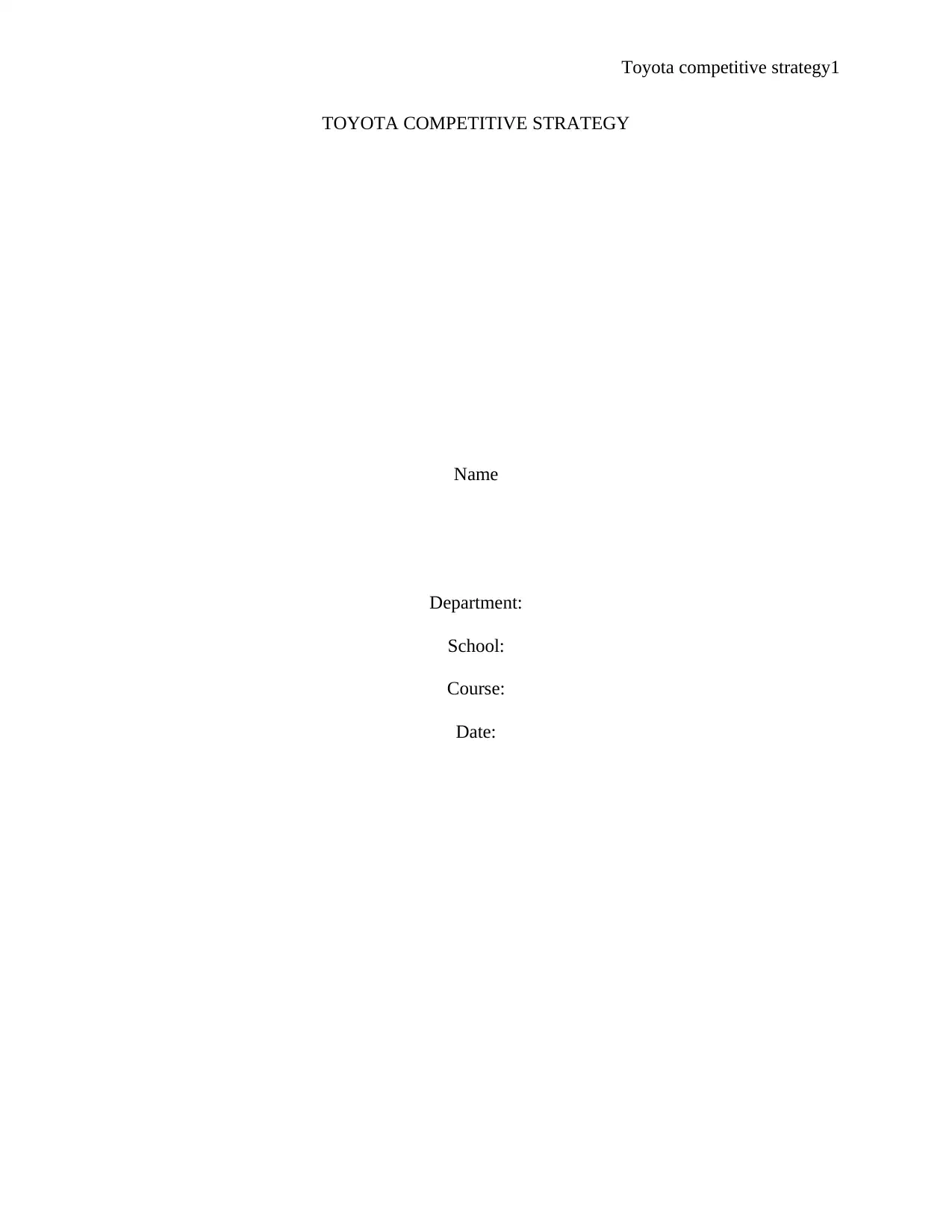
Toyota competitive strategy1
TOYOTA COMPETITIVE STRATEGY
Name
Department:
School:
Course:
Date:
TOYOTA COMPETITIVE STRATEGY
Name
Department:
School:
Course:
Date:
Paraphrase This Document
Need a fresh take? Get an instant paraphrase of this document with our AI Paraphraser
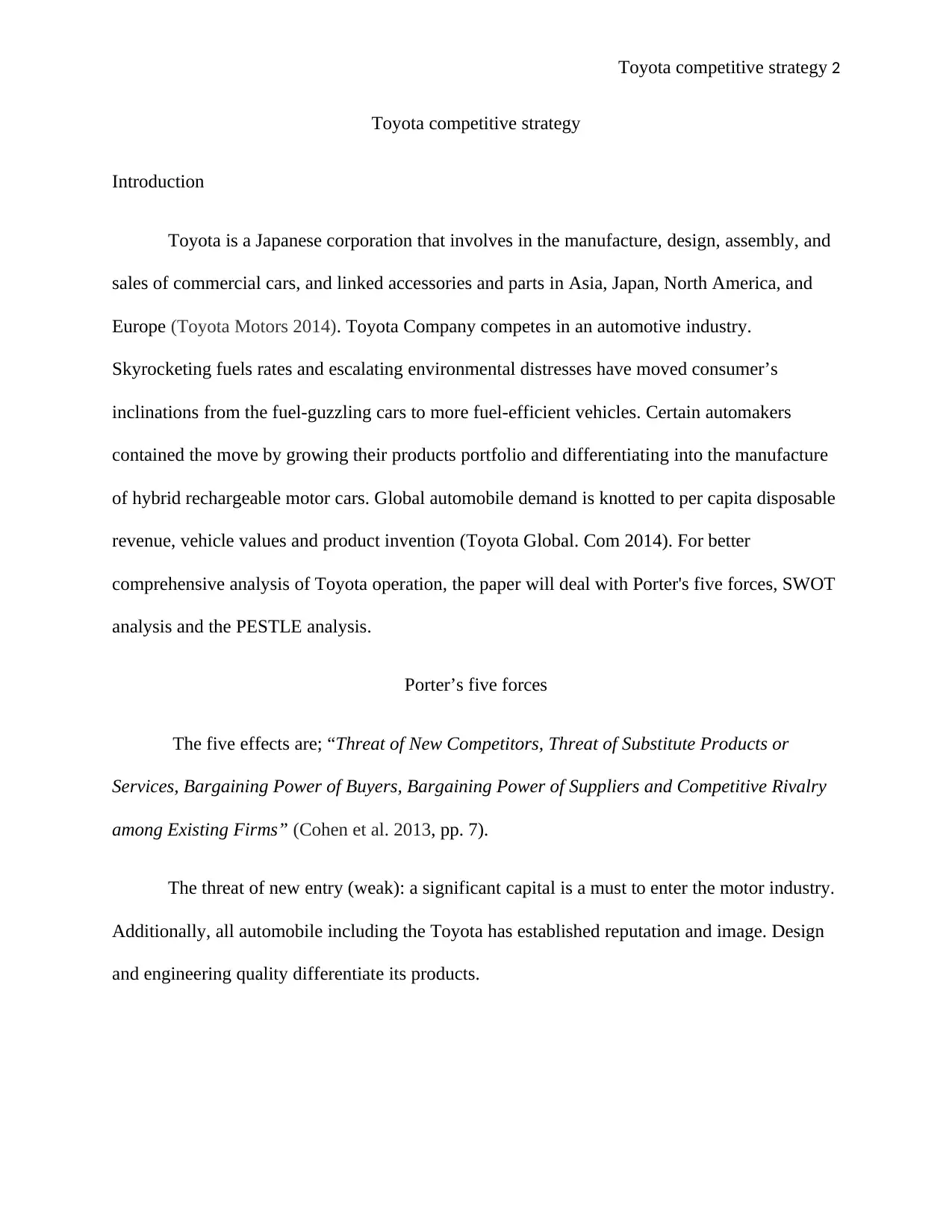
Toyota competitive strategy 2
Toyota competitive strategy
Introduction
Toyota is a Japanese corporation that involves in the manufacture, design, assembly, and
sales of commercial cars, and linked accessories and parts in Asia, Japan, North America, and
Europe (Toyota Motors 2014). Toyota Company competes in an automotive industry.
Skyrocketing fuels rates and escalating environmental distresses have moved consumer’s
inclinations from the fuel-guzzling cars to more fuel-efficient vehicles. Certain automakers
contained the move by growing their products portfolio and differentiating into the manufacture
of hybrid rechargeable motor cars. Global automobile demand is knotted to per capita disposable
revenue, vehicle values and product invention (Toyota Global. Com 2014). For better
comprehensive analysis of Toyota operation, the paper will deal with Porter's five forces, SWOT
analysis and the PESTLE analysis.
Porter’s five forces
The five effects are; “Threat of New Competitors, Threat of Substitute Products or
Services, Bargaining Power of Buyers, Bargaining Power of Suppliers and Competitive Rivalry
among Existing Firms” (Cohen et al. 2013, pp. 7).
The threat of new entry (weak): a significant capital is a must to enter the motor industry.
Additionally, all automobile including the Toyota has established reputation and image. Design
and engineering quality differentiate its products.
Toyota competitive strategy
Introduction
Toyota is a Japanese corporation that involves in the manufacture, design, assembly, and
sales of commercial cars, and linked accessories and parts in Asia, Japan, North America, and
Europe (Toyota Motors 2014). Toyota Company competes in an automotive industry.
Skyrocketing fuels rates and escalating environmental distresses have moved consumer’s
inclinations from the fuel-guzzling cars to more fuel-efficient vehicles. Certain automakers
contained the move by growing their products portfolio and differentiating into the manufacture
of hybrid rechargeable motor cars. Global automobile demand is knotted to per capita disposable
revenue, vehicle values and product invention (Toyota Global. Com 2014). For better
comprehensive analysis of Toyota operation, the paper will deal with Porter's five forces, SWOT
analysis and the PESTLE analysis.
Porter’s five forces
The five effects are; “Threat of New Competitors, Threat of Substitute Products or
Services, Bargaining Power of Buyers, Bargaining Power of Suppliers and Competitive Rivalry
among Existing Firms” (Cohen et al. 2013, pp. 7).
The threat of new entry (weak): a significant capital is a must to enter the motor industry.
Additionally, all automobile including the Toyota has established reputation and image. Design
and engineering quality differentiate its products.
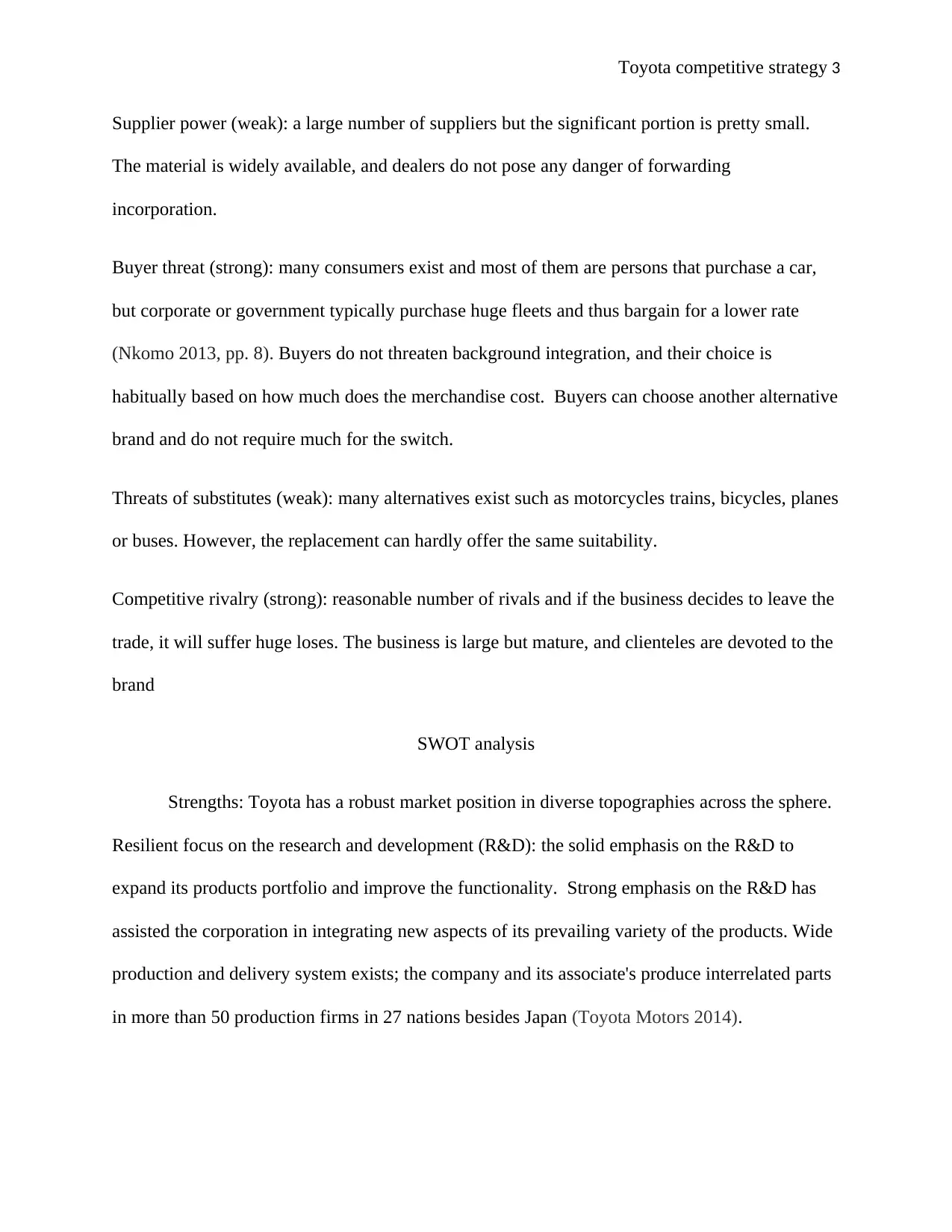
Toyota competitive strategy 3
Supplier power (weak): a large number of suppliers but the significant portion is pretty small.
The material is widely available, and dealers do not pose any danger of forwarding
incorporation.
Buyer threat (strong): many consumers exist and most of them are persons that purchase a car,
but corporate or government typically purchase huge fleets and thus bargain for a lower rate
(Nkomo 2013, pp. 8). Buyers do not threaten background integration, and their choice is
habitually based on how much does the merchandise cost. Buyers can choose another alternative
brand and do not require much for the switch.
Threats of substitutes (weak): many alternatives exist such as motorcycles trains, bicycles, planes
or buses. However, the replacement can hardly offer the same suitability.
Competitive rivalry (strong): reasonable number of rivals and if the business decides to leave the
trade, it will suffer huge loses. The business is large but mature, and clienteles are devoted to the
brand
SWOT analysis
Strengths: Toyota has a robust market position in diverse topographies across the sphere.
Resilient focus on the research and development (R&D): the solid emphasis on the R&D to
expand its products portfolio and improve the functionality. Strong emphasis on the R&D has
assisted the corporation in integrating new aspects of its prevailing variety of the products. Wide
production and delivery system exists; the company and its associate's produce interrelated parts
in more than 50 production firms in 27 nations besides Japan (Toyota Motors 2014).
Supplier power (weak): a large number of suppliers but the significant portion is pretty small.
The material is widely available, and dealers do not pose any danger of forwarding
incorporation.
Buyer threat (strong): many consumers exist and most of them are persons that purchase a car,
but corporate or government typically purchase huge fleets and thus bargain for a lower rate
(Nkomo 2013, pp. 8). Buyers do not threaten background integration, and their choice is
habitually based on how much does the merchandise cost. Buyers can choose another alternative
brand and do not require much for the switch.
Threats of substitutes (weak): many alternatives exist such as motorcycles trains, bicycles, planes
or buses. However, the replacement can hardly offer the same suitability.
Competitive rivalry (strong): reasonable number of rivals and if the business decides to leave the
trade, it will suffer huge loses. The business is large but mature, and clienteles are devoted to the
brand
SWOT analysis
Strengths: Toyota has a robust market position in diverse topographies across the sphere.
Resilient focus on the research and development (R&D): the solid emphasis on the R&D to
expand its products portfolio and improve the functionality. Strong emphasis on the R&D has
assisted the corporation in integrating new aspects of its prevailing variety of the products. Wide
production and delivery system exists; the company and its associate's produce interrelated parts
in more than 50 production firms in 27 nations besides Japan (Toyota Motors 2014).
⊘ This is a preview!⊘
Do you want full access?
Subscribe today to unlock all pages.

Trusted by 1+ million students worldwide
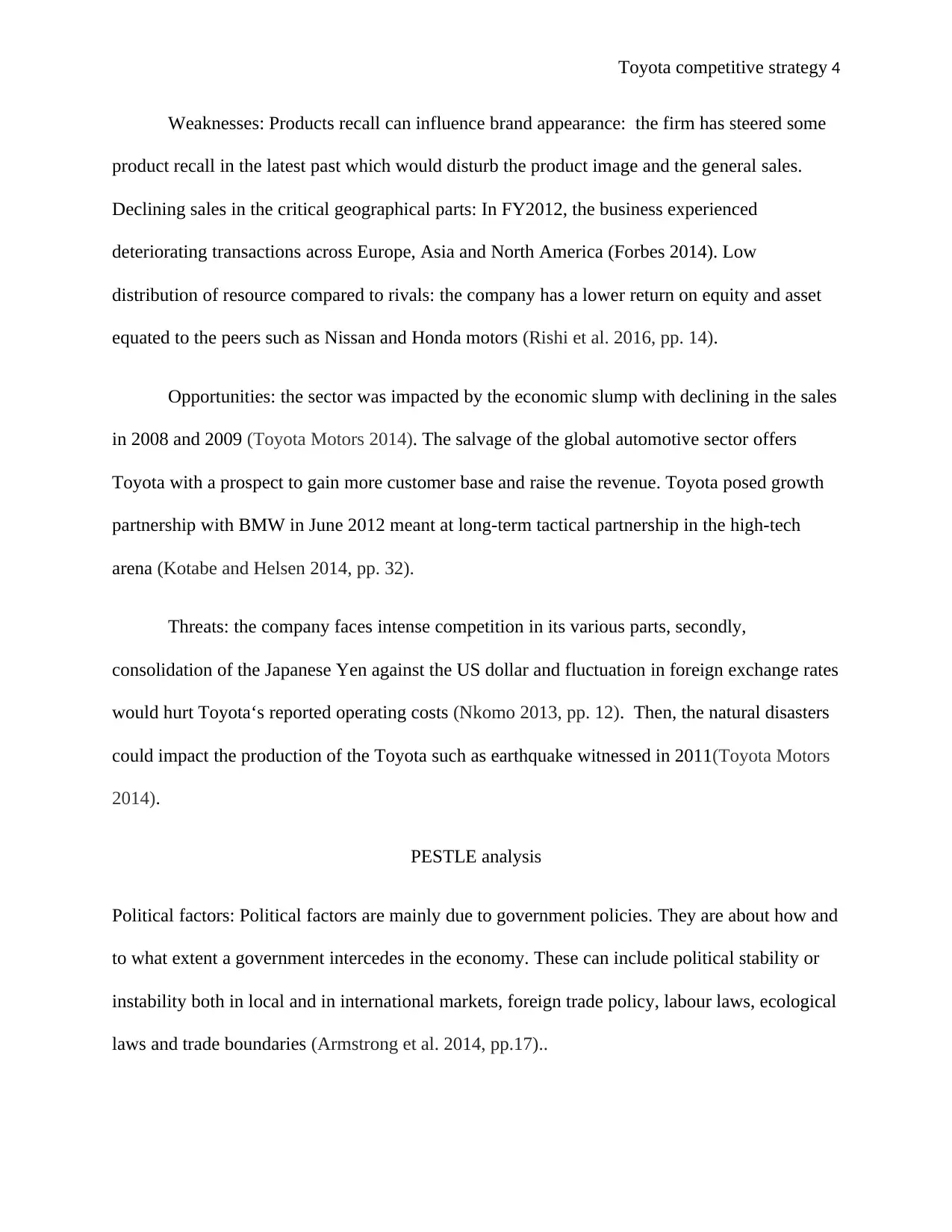
Toyota competitive strategy 4
Weaknesses: Products recall can influence brand appearance: the firm has steered some
product recall in the latest past which would disturb the product image and the general sales.
Declining sales in the critical geographical parts: In FY2012, the business experienced
deteriorating transactions across Europe, Asia and North America (Forbes 2014). Low
distribution of resource compared to rivals: the company has a lower return on equity and asset
equated to the peers such as Nissan and Honda motors (Rishi et al. 2016, pp. 14).
Opportunities: the sector was impacted by the economic slump with declining in the sales
in 2008 and 2009 (Toyota Motors 2014). The salvage of the global automotive sector offers
Toyota with a prospect to gain more customer base and raise the revenue. Toyota posed growth
partnership with BMW in June 2012 meant at long-term tactical partnership in the high-tech
arena (Kotabe and Helsen 2014, pp. 32).
Threats: the company faces intense competition in its various parts, secondly,
consolidation of the Japanese Yen against the US dollar and fluctuation in foreign exchange rates
would hurt Toyota‘s reported operating costs (Nkomo 2013, pp. 12). Then, the natural disasters
could impact the production of the Toyota such as earthquake witnessed in 2011(Toyota Motors
2014).
PESTLE analysis
Political factors: Political factors are mainly due to government policies. They are about how and
to what extent a government intercedes in the economy. These can include political stability or
instability both in local and in international markets, foreign trade policy, labour laws, ecological
laws and trade boundaries (Armstrong et al. 2014, pp.17)..
Weaknesses: Products recall can influence brand appearance: the firm has steered some
product recall in the latest past which would disturb the product image and the general sales.
Declining sales in the critical geographical parts: In FY2012, the business experienced
deteriorating transactions across Europe, Asia and North America (Forbes 2014). Low
distribution of resource compared to rivals: the company has a lower return on equity and asset
equated to the peers such as Nissan and Honda motors (Rishi et al. 2016, pp. 14).
Opportunities: the sector was impacted by the economic slump with declining in the sales
in 2008 and 2009 (Toyota Motors 2014). The salvage of the global automotive sector offers
Toyota with a prospect to gain more customer base and raise the revenue. Toyota posed growth
partnership with BMW in June 2012 meant at long-term tactical partnership in the high-tech
arena (Kotabe and Helsen 2014, pp. 32).
Threats: the company faces intense competition in its various parts, secondly,
consolidation of the Japanese Yen against the US dollar and fluctuation in foreign exchange rates
would hurt Toyota‘s reported operating costs (Nkomo 2013, pp. 12). Then, the natural disasters
could impact the production of the Toyota such as earthquake witnessed in 2011(Toyota Motors
2014).
PESTLE analysis
Political factors: Political factors are mainly due to government policies. They are about how and
to what extent a government intercedes in the economy. These can include political stability or
instability both in local and in international markets, foreign trade policy, labour laws, ecological
laws and trade boundaries (Armstrong et al. 2014, pp.17)..
Paraphrase This Document
Need a fresh take? Get an instant paraphrase of this document with our AI Paraphraser
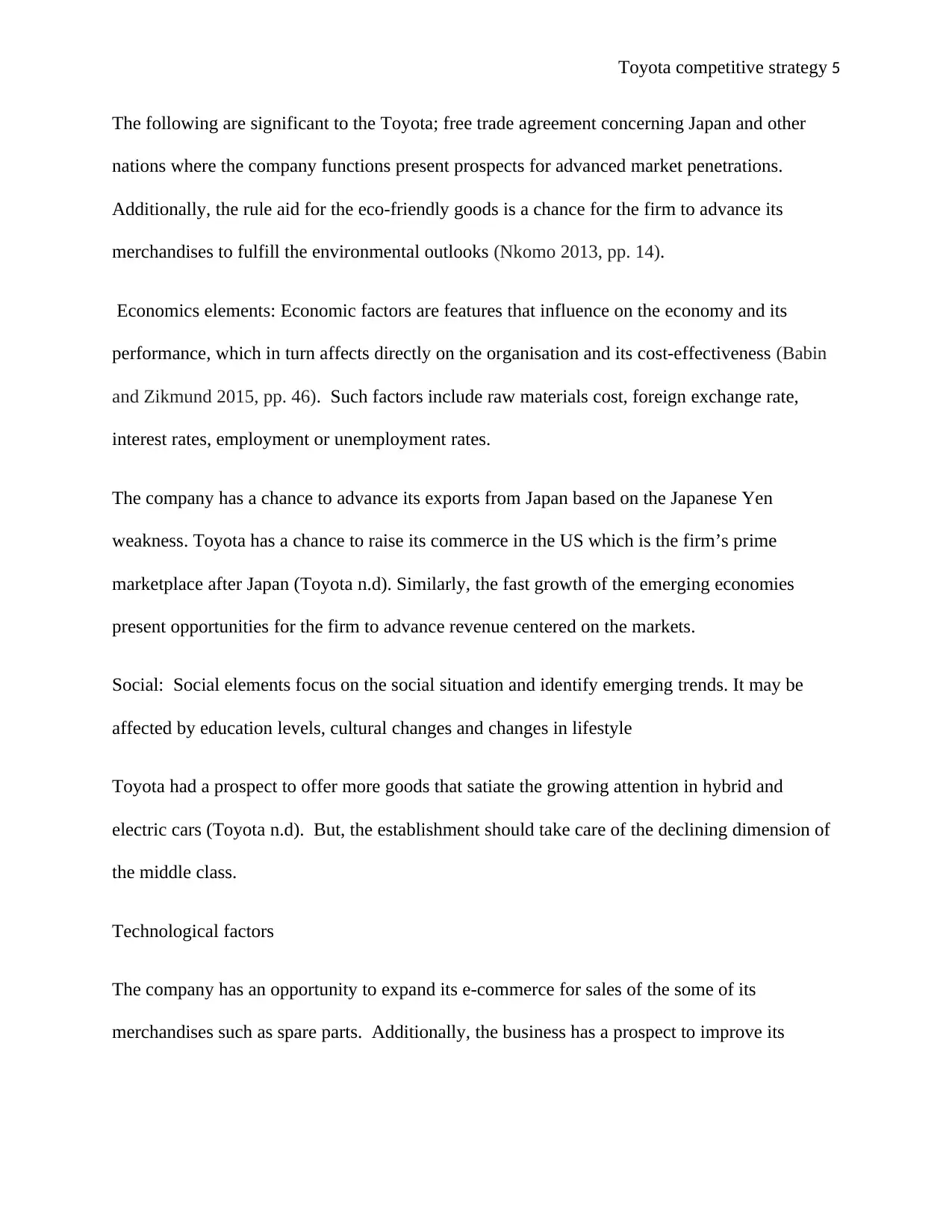
Toyota competitive strategy 5
The following are significant to the Toyota; free trade agreement concerning Japan and other
nations where the company functions present prospects for advanced market penetrations.
Additionally, the rule aid for the eco-friendly goods is a chance for the firm to advance its
merchandises to fulfill the environmental outlooks (Nkomo 2013, pp. 14).
Economics elements: Economic factors are features that influence on the economy and its
performance, which in turn affects directly on the organisation and its cost-effectiveness (Babin
and Zikmund 2015, pp. 46). Such factors include raw materials cost, foreign exchange rate,
interest rates, employment or unemployment rates.
The company has a chance to advance its exports from Japan based on the Japanese Yen
weakness. Toyota has a chance to raise its commerce in the US which is the firm’s prime
marketplace after Japan (Toyota n.d). Similarly, the fast growth of the emerging economies
present opportunities for the firm to advance revenue centered on the markets.
Social: Social elements focus on the social situation and identify emerging trends. It may be
affected by education levels, cultural changes and changes in lifestyle
Toyota had a prospect to offer more goods that satiate the growing attention in hybrid and
electric cars (Toyota n.d). But, the establishment should take care of the declining dimension of
the middle class.
Technological factors
The company has an opportunity to expand its e-commerce for sales of the some of its
merchandises such as spare parts. Additionally, the business has a prospect to improve its
The following are significant to the Toyota; free trade agreement concerning Japan and other
nations where the company functions present prospects for advanced market penetrations.
Additionally, the rule aid for the eco-friendly goods is a chance for the firm to advance its
merchandises to fulfill the environmental outlooks (Nkomo 2013, pp. 14).
Economics elements: Economic factors are features that influence on the economy and its
performance, which in turn affects directly on the organisation and its cost-effectiveness (Babin
and Zikmund 2015, pp. 46). Such factors include raw materials cost, foreign exchange rate,
interest rates, employment or unemployment rates.
The company has a chance to advance its exports from Japan based on the Japanese Yen
weakness. Toyota has a chance to raise its commerce in the US which is the firm’s prime
marketplace after Japan (Toyota n.d). Similarly, the fast growth of the emerging economies
present opportunities for the firm to advance revenue centered on the markets.
Social: Social elements focus on the social situation and identify emerging trends. It may be
affected by education levels, cultural changes and changes in lifestyle
Toyota had a prospect to offer more goods that satiate the growing attention in hybrid and
electric cars (Toyota n.d). But, the establishment should take care of the declining dimension of
the middle class.
Technological factors
The company has an opportunity to expand its e-commerce for sales of the some of its
merchandises such as spare parts. Additionally, the business has a prospect to improve its
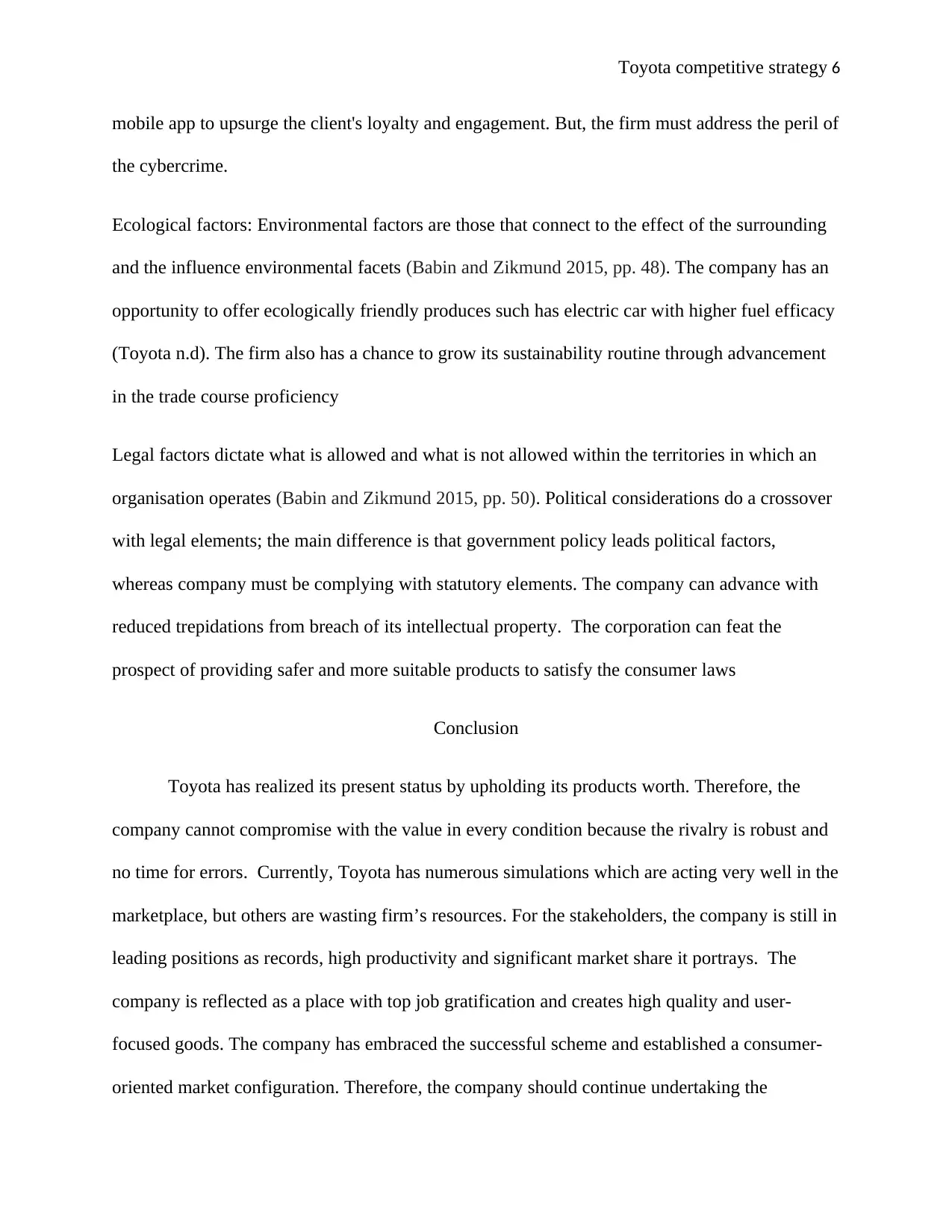
Toyota competitive strategy 6
mobile app to upsurge the client's loyalty and engagement. But, the firm must address the peril of
the cybercrime.
Ecological factors: Environmental factors are those that connect to the effect of the surrounding
and the influence environmental facets (Babin and Zikmund 2015, pp. 48). The company has an
opportunity to offer ecologically friendly produces such has electric car with higher fuel efficacy
(Toyota n.d). The firm also has a chance to grow its sustainability routine through advancement
in the trade course proficiency
Legal factors dictate what is allowed and what is not allowed within the territories in which an
organisation operates (Babin and Zikmund 2015, pp. 50). Political considerations do a crossover
with legal elements; the main difference is that government policy leads political factors,
whereas company must be complying with statutory elements. The company can advance with
reduced trepidations from breach of its intellectual property. The corporation can feat the
prospect of providing safer and more suitable products to satisfy the consumer laws
Conclusion
Toyota has realized its present status by upholding its products worth. Therefore, the
company cannot compromise with the value in every condition because the rivalry is robust and
no time for errors. Currently, Toyota has numerous simulations which are acting very well in the
marketplace, but others are wasting firm’s resources. For the stakeholders, the company is still in
leading positions as records, high productivity and significant market share it portrays. The
company is reflected as a place with top job gratification and creates high quality and user-
focused goods. The company has embraced the successful scheme and established a consumer-
oriented market configuration. Therefore, the company should continue undertaking the
mobile app to upsurge the client's loyalty and engagement. But, the firm must address the peril of
the cybercrime.
Ecological factors: Environmental factors are those that connect to the effect of the surrounding
and the influence environmental facets (Babin and Zikmund 2015, pp. 48). The company has an
opportunity to offer ecologically friendly produces such has electric car with higher fuel efficacy
(Toyota n.d). The firm also has a chance to grow its sustainability routine through advancement
in the trade course proficiency
Legal factors dictate what is allowed and what is not allowed within the territories in which an
organisation operates (Babin and Zikmund 2015, pp. 50). Political considerations do a crossover
with legal elements; the main difference is that government policy leads political factors,
whereas company must be complying with statutory elements. The company can advance with
reduced trepidations from breach of its intellectual property. The corporation can feat the
prospect of providing safer and more suitable products to satisfy the consumer laws
Conclusion
Toyota has realized its present status by upholding its products worth. Therefore, the
company cannot compromise with the value in every condition because the rivalry is robust and
no time for errors. Currently, Toyota has numerous simulations which are acting very well in the
marketplace, but others are wasting firm’s resources. For the stakeholders, the company is still in
leading positions as records, high productivity and significant market share it portrays. The
company is reflected as a place with top job gratification and creates high quality and user-
focused goods. The company has embraced the successful scheme and established a consumer-
oriented market configuration. Therefore, the company should continue undertaking the
⊘ This is a preview!⊘
Do you want full access?
Subscribe today to unlock all pages.

Trusted by 1+ million students worldwide
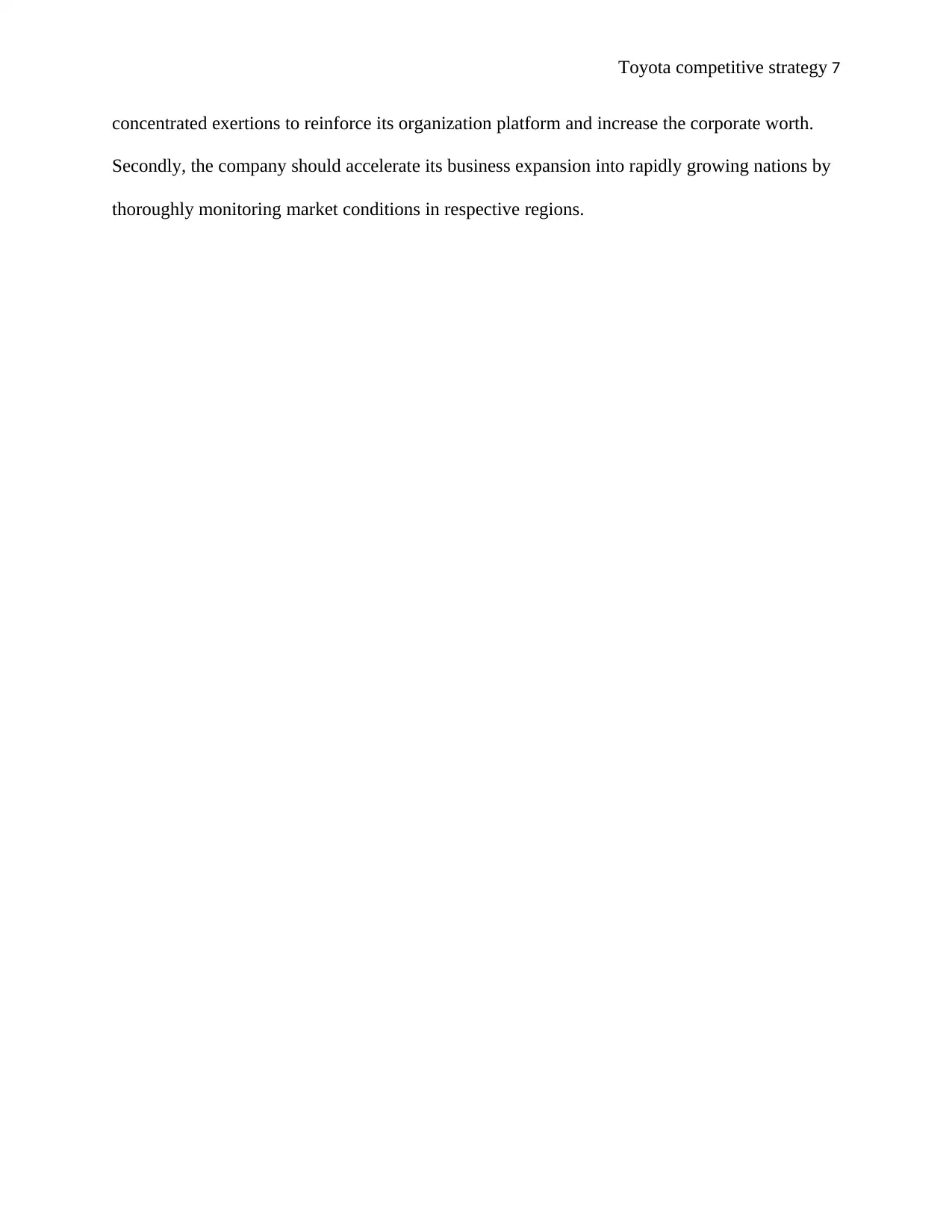
Toyota competitive strategy 7
concentrated exertions to reinforce its organization platform and increase the corporate worth.
Secondly, the company should accelerate its business expansion into rapidly growing nations by
thoroughly monitoring market conditions in respective regions.
concentrated exertions to reinforce its organization platform and increase the corporate worth.
Secondly, the company should accelerate its business expansion into rapidly growing nations by
thoroughly monitoring market conditions in respective regions.
Paraphrase This Document
Need a fresh take? Get an instant paraphrase of this document with our AI Paraphraser
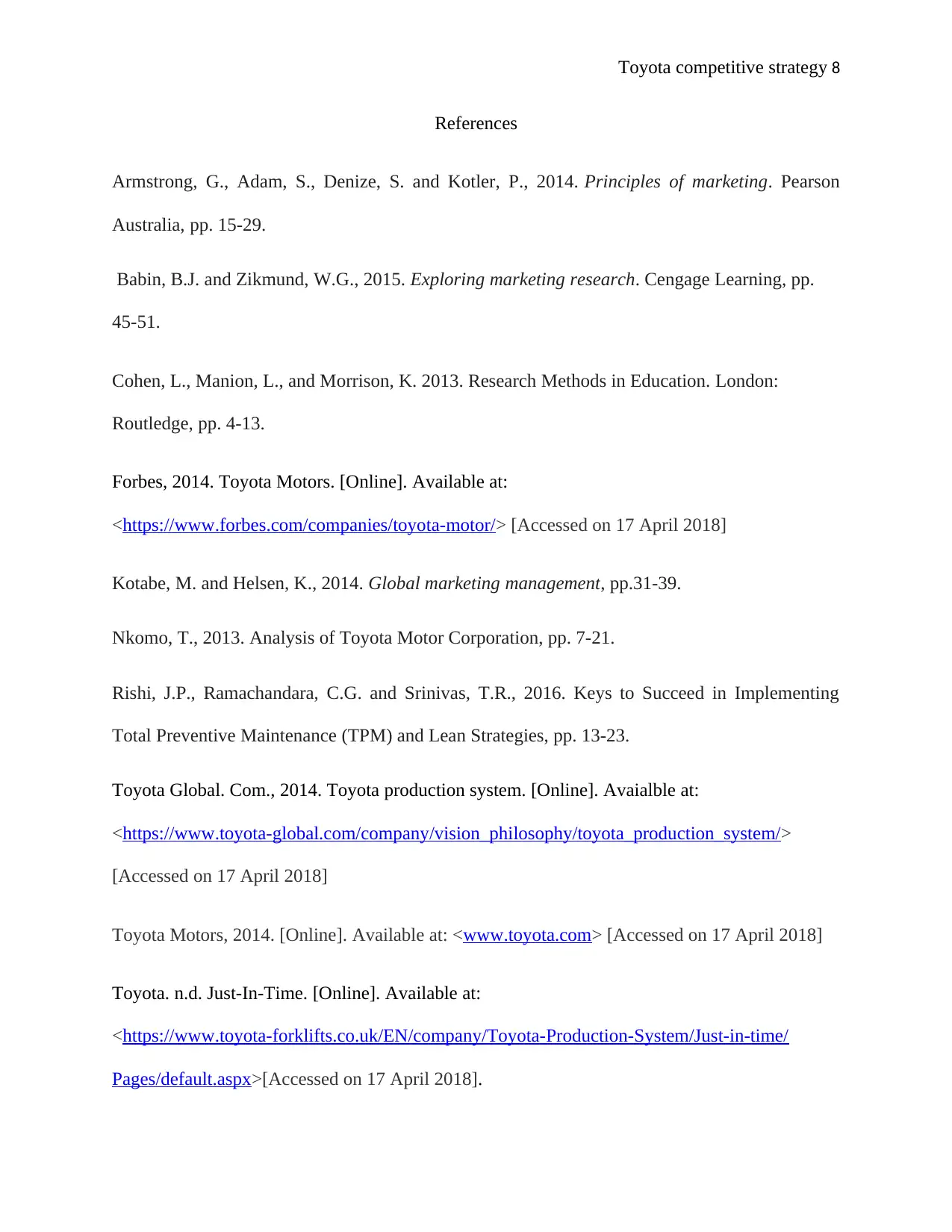
Toyota competitive strategy 8
References
Armstrong, G., Adam, S., Denize, S. and Kotler, P., 2014. Principles of marketing. Pearson
Australia, pp. 15-29.
Babin, B.J. and Zikmund, W.G., 2015. Exploring marketing research. Cengage Learning, pp.
45-51.
Cohen, L., Manion, L., and Morrison, K. 2013. Research Methods in Education. London:
Routledge, pp. 4-13.
Forbes, 2014. Toyota Motors. [Online]. Available at:
<https://www.forbes.com/companies/toyota-motor/> [Accessed on 17 April 2018]
Kotabe, M. and Helsen, K., 2014. Global marketing management, pp.31-39.
Nkomo, T., 2013. Analysis of Toyota Motor Corporation, pp. 7-21.
Rishi, J.P., Ramachandara, C.G. and Srinivas, T.R., 2016. Keys to Succeed in Implementing
Total Preventive Maintenance (TPM) and Lean Strategies, pp. 13-23.
Toyota Global. Com., 2014. Toyota production system. [Online]. Avaialble at:
<https://www.toyota-global.com/company/vision_philosophy/toyota_production_system/>
[Accessed on 17 April 2018]
Toyota Motors, 2014. [Online]. Available at: <www.toyota.com> [Accessed on 17 April 2018]
Toyota. n.d. Just-In-Time. [Online]. Available at:
<https://www.toyota-forklifts.co.uk/EN/company/Toyota-Production-System/Just-in-time/
Pages/default.aspx>[Accessed on 17 April 2018].
References
Armstrong, G., Adam, S., Denize, S. and Kotler, P., 2014. Principles of marketing. Pearson
Australia, pp. 15-29.
Babin, B.J. and Zikmund, W.G., 2015. Exploring marketing research. Cengage Learning, pp.
45-51.
Cohen, L., Manion, L., and Morrison, K. 2013. Research Methods in Education. London:
Routledge, pp. 4-13.
Forbes, 2014. Toyota Motors. [Online]. Available at:
<https://www.forbes.com/companies/toyota-motor/> [Accessed on 17 April 2018]
Kotabe, M. and Helsen, K., 2014. Global marketing management, pp.31-39.
Nkomo, T., 2013. Analysis of Toyota Motor Corporation, pp. 7-21.
Rishi, J.P., Ramachandara, C.G. and Srinivas, T.R., 2016. Keys to Succeed in Implementing
Total Preventive Maintenance (TPM) and Lean Strategies, pp. 13-23.
Toyota Global. Com., 2014. Toyota production system. [Online]. Avaialble at:
<https://www.toyota-global.com/company/vision_philosophy/toyota_production_system/>
[Accessed on 17 April 2018]
Toyota Motors, 2014. [Online]. Available at: <www.toyota.com> [Accessed on 17 April 2018]
Toyota. n.d. Just-In-Time. [Online]. Available at:
<https://www.toyota-forklifts.co.uk/EN/company/Toyota-Production-System/Just-in-time/
Pages/default.aspx>[Accessed on 17 April 2018].
1 out of 8
Related Documents
Your All-in-One AI-Powered Toolkit for Academic Success.
+13062052269
info@desklib.com
Available 24*7 on WhatsApp / Email
![[object Object]](/_next/static/media/star-bottom.7253800d.svg)
Unlock your academic potential
Copyright © 2020–2025 A2Z Services. All Rights Reserved. Developed and managed by ZUCOL.





